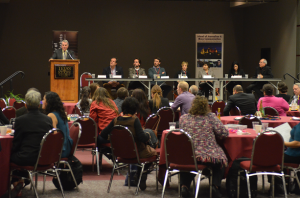The Study of Latinos and Media, Not A Dead End

 By Kara Andrade, Habla Centro
By Kara Andrade, Habla Centro
When I graduated from UC Berkeley’s Master’s Program in Journalism in 2007, I could count on one hand the number of Latinos in my class. I also noticed a similar pattern in those dying mainstream newsrooms I worked in, and later on, as I begun to study the Latino media in the United States, as part of my work in Central America to connect immigrants to their home countries’ stories.
These patterns were misleading because in the United States, the Latino population grew to more than 50 million, according to the 2010 U.S. Census, more than double its size in 1990, and up 46.3 percent since 2000. Moreover, Latinos are now more bilingual and young –they are the nation’s youngest ethnic group with a median age of 27 in comparison to non-Hispanic whites media age of 42, and non-Hispanic blacks at 32– and increasingly U.S.-born. And with a purchasing power of $1 trillion per year, expected to grow another 50 percent to $1.5 trillion in the next five years, according to a 2012 Nielsen report, Latinos in the U.S. are getting their information when they want it and on their own terms.
Nevertheless, many Hispanics are still getting their news in Spanish. Pew Research Center’s report on State of the News Media report from 2011, shows some of the trends in consumption by Latinos. Univision’s television network is now the fifth-largest network in primetime audience in the United States; the number of Spanish-language radio stations increased in 2010; and even the longstanding, flagship Hispanic newspapers saw slight decreases in print circulation compared to their English-language counterparts, magazines showed a year-over-year growth in ad spending. On the digital front, bilingual Latinos are already heavily online. Overall, Spanish-language media tended to fare better overall than mainstream English-language media, the report concludes.
Federico Subervi, author of “The Mass Media and Latino Politics: Studies of U.S. Media Content, Campaign Strategies and Survey Research: 1984-2004” predicted this growth in the Latino population, and the change in media consumption patterns thirty years ago. While he was in college in Wisconsin he wrote extensively about a more acculturated, U.S.-born Hispanic population would change the face of the nation and its media.
“The Latino population is growing, has been growing and will continue to grow,” Subervi wrote. “People pay attention to the media that they find most culturally relevant. It’s also not one homogenous Latino media, it’s many Latino media providing diverse content that meets the diverse interest of this growing Latino population.” Subervi, currently the director of the Center for the Study of Latino Media and Markets at the School of Journalism and Mass Communication at Texas State University in San Marcos, is behind the Assessing The State of Spanish-Language & Latino-Oriented Media conference, now in its fourth year, that took place in the San Marcos campus February 21st to 23rd. More than 170 attendees, academics, journalists and presenters from the U.S., Mexico and Spain attended the event. Subervi said that the increase in conference attendees reflects the growth of Latino-oriented media and interest in the field. More importantly, for Subervi, it proves that the study of Latinos and media is not a “dead end” field with no future as some suggested.
“The faculty and the students, Latinos and non-Latinos, are saying ‘Hey this is something interesting, a growing population, they make a lot of money to spend, they make a difference on politics, what’s moving all of that? Media, English, Spanish or bi-lingual; online, radio, print or television… let’s study those’ and that’s what we’re doing here,” he said.
While the numbers related to the growth of the Latino population are exponential, as well as the consumption patterns and the content delivered to the diverse group of Latinos in the U.S., the number of Latinos studying Latinos in media has not experienced such significant changes. A 2011 report from the National Communication Association states that only 3.1 percent of the students obtaining Ph.D. degrees in the area of Communication are of Hispanic descent. “There are not a lot of people out there studying this,” said Timothy Mottet, Dean of the College of Fine Arts and Communication at Texas State University in San Marcos.
“Eventually Hispanics will become the majority and this ‘dead end’ concept will disappear,” Mottet said. [But] “I think that’s a long way off – just because you have the population that doesn’t mean you have the power structure to make that happen.”
Kara Andrade is an Ashoka Fellow working in Central America coordinating HablaCentro, an organization and technology platform that allows users to send and receive information via text messages that are also posted to local hub websites in Guatemala, Honduras, El Salvador, Costa Rica, and Venezuela. She was funded by the U.S. State Department to implement a mobile-based citizen-journalism website in her native Guatemala. She has 10 years experience in nonprofit development, public health and community organizing. She worked as a multimedia producer and photojournalist for Agence France-Presse, Americas Quarterly, Associated Press, Christian Science Monitor, France 24, Global Post, ReVista: Harvard Review of Latin America, The New York Times and other publications. She holds an M.A. in journalism from the University of California Berkeley.

